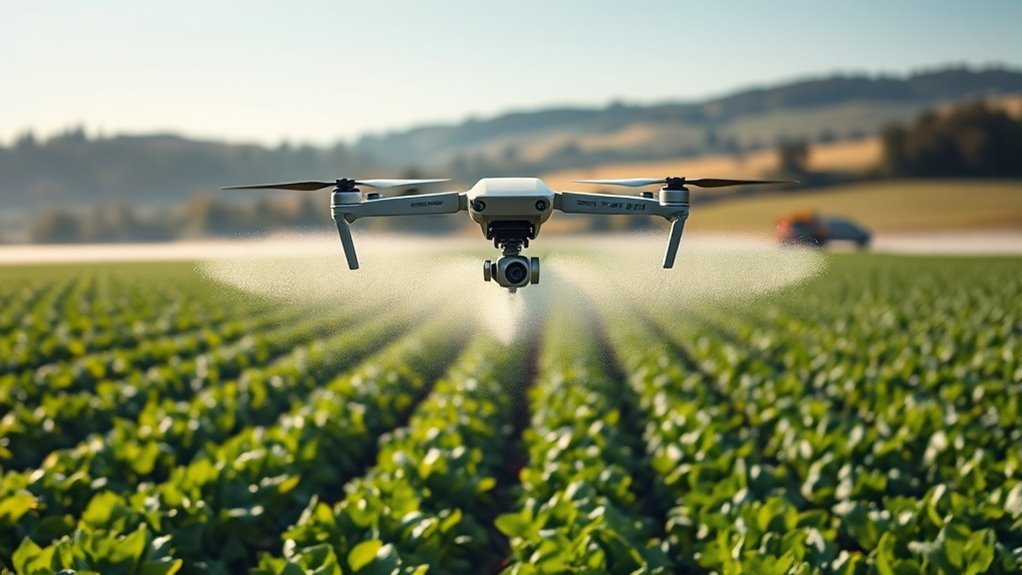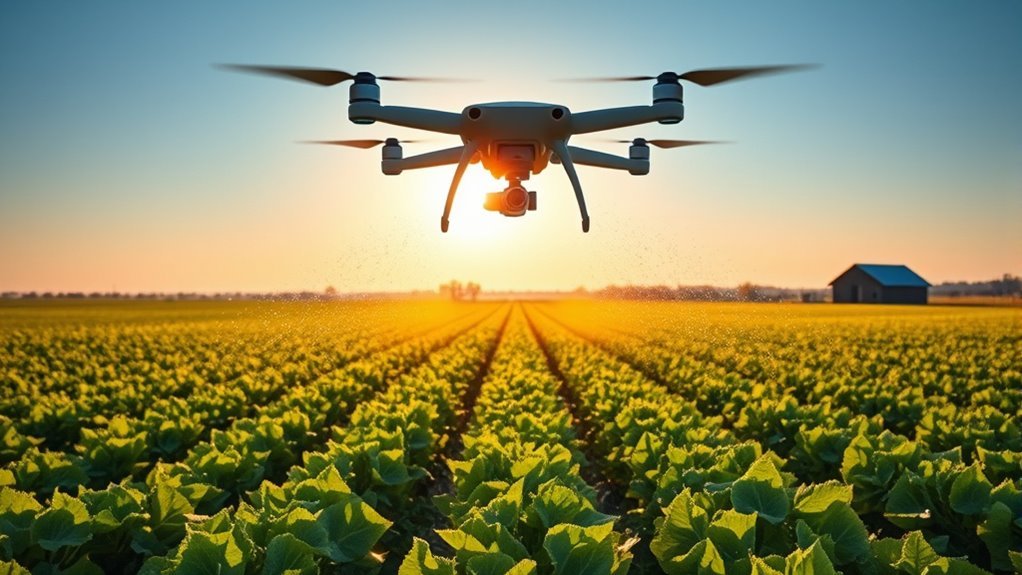In agriculture, drones are primarily used to spray essential inputs like pesticides, herbicides, fertilizers, and nutrients. They employ advanced technology for precision application, which minimizes waste and environmental impact. This targeted approach enhances crop management and boosts yields. Additionally, drones collect real-time data on crop conditions and soil health, further aiding effective decision-making. As you explore this topic, you’ll uncover more about their benefits and implications for sustainable agriculture.
Overview of Drone Technology in Agriculture

As agriculture faces increasing challenges such as climate change and population growth, drone technology emerges as a transformative tool that can enhance efficiency and productivity. You’ll find that drone capabilities are revolutionizing the way farmers monitor crops, manage resources, and optimize yields. Equipped with advanced sensors and imaging technology, drones enable precision agriculture, allowing you to gather real-time data on soil health, crop conditions, and pest infestations. This agricultural innovation not only streamlines operations but also reduces waste and maximizes outputs. By integrating drones into farming practices, you’re tapping into a powerful resource that supports sustainable growth. Delair’s cameras provide high-resolution imaging that enhances crop health monitoring, empowering you to make informed decisions. Additionally, real-time detection of inefficiencies optimizes water and energy consumption in operations, further enhancing resource management. Embracing these technologies can empower you, allowing for greater autonomy and more informed decision-making in your agricultural endeavors.
Common Agricultural Inputs Sprayed by Drones

When you consider the use of drones in agriculture, it’s crucial to recognize the various inputs they can spray effectively. Pesticides, herbicides, fertilizers, and fungicides are among the most common agricultural inputs utilized through drone technology, enhancing precision and efficiency. Understanding the specific applications of these inputs can greatly impact crop health and yield. Additionally, drones equipped with precision crop and pest detection technologies can optimize spraying by ensuring that treatments are applied only where necessary, further improving sustainability and reducing waste.
Pesticides and Herbicides
Drones have revolutionized the application of pesticides and herbicides in agriculture, enabling farmers to target specific areas with precision. This targeted approach can greatly enhance pesticide effectiveness while minimizing waste and environmental impact.
Key benefits of using drones for pesticide and herbicide application include:
- Improved coverage of difficult terrain
- Reduction in chemical usage
- Enhanced monitoring of crop health
- Timely intervention to combat herbicide resistance
- Real-time data collection for informed decision-making
Fertilizers and Nutrients
While the use of drones has primarily gained attention for pesticide application, their role in the distribution of fertilizers and nutrients is equally transformative. Drones enhance fertilizer application by ensuring precise delivery, reducing waste, and minimizing environmental impact. With advanced sensors and mapping technologies, they facilitate effective nutrient management, allowing you to target specific areas based on crop needs. This targeted approach not only optimizes growth but also conserves resources, aligning with sustainable farming practices. By utilizing drones for nutrient distribution, you can achieve greater efficiency, improve crop yield, and reduce labor costs. In a world where agricultural freedom is paramount, embracing drone technology could revolutionize how you manage your fertile lands, ensuring a more productive and sustainable future.
Fungicides and Insecticides
The application of fungicides and insecticides via drones has become an essential practice in modern agriculture, with studies showing that precision spraying can reduce chemical usage by up to 30%. This innovative method enhances fungicide effectiveness and helps combat insecticide resistance, ensuring healthier crops and sustainable farming.
- Drones offer targeted application, minimizing waste.
- Enhanced coverage leads to improved pest control.
- Real-time data collection allows for timely interventions.
- Reduces human exposure to harmful chemicals.
- Supports integrated pest management strategies.
Benefits of Drone Spraying for Crop Management

When you consider drone spraying for crop management, you’ll find it offers precision application techniques that minimize waste and maximize efficacy. Moreover, the time and labor savings can greatly enhance operational efficiency, allowing you to focus on other critical aspects of farming. In addition, drones facilitate enhanced crop monitoring, providing real-time data that can inform better decision-making. Additionally, advanced AI integration in drone technology further enhances the ability to optimize agricultural practices. This technology allows for real-time field monitoring and adjustments based on live data, ensuring that spraying is conducted under ideal conditions.
Precision Application Techniques
Drones have transformed agriculture by enabling precision application techniques that considerably enhance crop management. By utilizing aerial mapping and precision targeting, you can optimize your resources and achieve better yields. Here are some key benefits of these techniques:
- Reduced chemical usage: Apply only where needed, minimizing environmental impact.
- Improved crop health: Deliver nutrients and pesticides with pinpoint accuracy, promoting plant vigor.
- Enhanced data collection: Gather detailed information for informed decision-making.
- Real-time monitoring: Assess crop conditions dynamically, addressing issues promptly.
- Cost-effectiveness: Streamline operations, reducing waste and increasing profitability.
Embracing these innovative methods empowers you to take control of your agricultural practices, ensuring efficient and sustainable crop management.
Time and Labor Savings
Utilizing drone spraying for crop management greatly reduces time and labor costs, allowing farmers to focus on other essential tasks. With drones, you can cover large areas quickly, considerably enhancing time efficiency compared to traditional methods. Instead of spending hours or even days manually spraying crops, drones can complete these tasks in a fraction of the time. This leads to substantial labor reduction, enabling you to allocate your workforce to more strategic activities, such as data analysis or maintenance. Furthermore, drone technology minimizes the need for specialized equipment and reduces the physical strain on workers. Ultimately, the integration of drones in agriculture streamlines operations, maximizing productivity and promoting a more efficient farming ecosystem.
Enhanced Crop Monitoring
As crop health directly impacts yield, incorporating drones into agricultural practices can considerably enhance monitoring capabilities. By utilizing aerial imagery, you can gain precise insights into your crops’ condition, allowing for timely interventions. Here are some benefits of enhanced crop monitoring through drone technology:
- Real-time data collection: Capture immediate information about crop health.
- Stress detection: Identify areas of water, nutrient, or pest stress before they become severe.
- Precision agriculture: Optimize inputs like fertilizers and pesticides based on specific needs.
- Field mapping: Create detailed maps that highlight variations in crop health across your fields.
- Cost-effective assessments: Reduce the need for manual inspections, saving time and labor.
With these advancements, you’re better equipped to maximize your yields and guarantee sustainable farming practices.
Environmental Impact of Drone-Assisted Spraying
While many farmers embrace drone-assisted spraying for its efficiency and precision, the environmental implications of this technology warrant careful consideration. You need to weigh the sustainability concerns that arise from chemical applications. Drones can deliver pesticides and fertilizers with remarkable accuracy, but this precision can also disrupt the ecological balance. Over-reliance on such methods might lead to pesticide drift, affecting non-target species and potentially harming beneficial insects. Additionally, the frequent use of chemicals can result in soil degradation and water contamination, further jeopardizing long-term agricultural productivity. It’s important to adopt drone technology responsibly, ensuring that it complements traditional practices rather than replacing them. By doing so, you can help foster an agricultural ecosystem that prioritizes both productivity and environmental health.
Precision Agriculture: Enhancing Efficiency
In an era where agricultural challenges are mounting, precision agriculture emerges as a critical solution to enhance efficiency and productivity. By integrating data analytics with advanced drone technology, you can greatly optimize your farming practices. Here’s how:
- Targeted Treatment: Apply fertilizers and pesticides only where needed, reducing waste.
- Soil Health Monitoring: Use drones to assess soil conditions and nutrient levels accurately.
- Crop Health Assessment: Quickly identify areas of stress or disease through aerial imagery.
- Resource Management: Optimize water usage, promoting sustainability and cost savings.
- Yield Prediction: Analyze data trends to forecast harvest outcomes, enabling better planning. Furthermore, precision agriculture enables independent decisions based on accurate data, reducing guesswork.
Regulatory Considerations for Drone Spraying
Maneuvering the regulatory landscape for drone spraying is essential for farmers looking to implement this innovative technology. Understanding the regulatory frameworks and safety standards can help guarantee compliance and mitigate risks. Here’s a quick overview of key considerations:
| Aspect | Regulatory Frameworks | Safety Standards |
|---|---|---|
| Licensing | Varies by region | Operator certification |
| Operational Limits | Altitude and distance limits | No-fly zones |
| Equipment Standards | Approved drone types | Maintenance protocols |
| Reporting Requirements | Incident reporting | Data collection guidelines |
Case Studies: Successful Drone Implementation
As farmers increasingly adopt drone technology, examining real-world applications reveals the significant benefits and operational efficiencies gained through successful implementations.
Here are some notable case studies:
Noteworthy case studies illustrate the transformative impact of drone technology on modern farming practices.
- Precision Spraying: Farmers in California use drones for targeted pesticide application, reducing chemical usage by up to 30%. This method aligns with advanced drone technology principles that enhance precision in agricultural practices.
- Crop Monitoring: A Midwest farm employs drones to assess crop health, enabling timely interventions and boosting yields.
- Irrigation Management: In Texas, drones help identify irrigation needs, optimizing water usage and conserving resources.
- Soil Analysis: A farm in Florida utilizes drones for detailed soil mapping, enhancing nutrient management strategies.
- Regulatory Adaptation: With proper drone training, farmers navigate regulatory challenges, ensuring compliance while maximizing efficiency.
Additionally, drones boost operational efficiency by streamlining processes and reducing manual labor in agricultural settings, further enhancing productivity.
These examples highlight how embracing drone technology can transform agricultural practices.
Future Trends in Drone Use for Agriculture
The successful implementation of drone technology in agriculture sets the stage for future advancements that promise to enhance efficiency and productivity further. One key trend is the integration of autonomous navigation systems, allowing drones to operate independently and optimize field coverage. This capability minimizes human intervention, enabling you to focus on strategic decision-making. Additionally, advancements in aerial mapping will enhance data accuracy, offering precise insights into crop health and soil conditions. As these technologies evolve, expect drones to deliver real-time analytics, enabling timely interventions that could considerably boost yields. Embracing these innovations will empower you to make informed decisions, ultimately leading to a more sustainable and profitable agricultural practice. Moreover, real-time monitoring through drones could enhance the detection of crop issues early, aligning with the trend of utilizing smart automation. The future of farming is certainly taking flight. Furthermore, integrating real-time data from field sensors into drone operations will allow for optimized irrigation and resource management, leading to increased crop health and reduced waste.
Frequently Asked Questions
How Do Farmers Choose Which Drones to Use for Spraying?
When selecting drones, you’ll weigh their specifications against your crop types, ensuring the chosen model glides gracefully through fields, delivering precision while optimizing yields. It’s a delicate dance of technology and nature’s bounty that you’ll navigate.
What Is the Cost of Implementing Drone Spraying Technology?
When considering the cost of implementing drone spraying technology, you’ll need a thorough cost analysis to understand the technology investment required. Initial expenses can be significant, but long-term savings and efficiency often justify the outlay.
Are There Safety Concerns With Drone Spraying Near Populated Areas?
Imagine a painter’s brush too close to a canvas’ edge; drone regulations aim to prevent pesticide drift near populated areas. You must weigh the benefits against safety concerns, ensuring community health remains a priority in agricultural practices.
How Do Weather Conditions Affect Drone Spraying Effectiveness?
Weather conditions markedly impact drone spraying effectiveness. High wind conditions can cause drift, while humidity levels influence droplet evaporation. Understanding these factors is essential for optimizing application accuracy and ensuring effective treatment of agricultural fields.
Can Drones Be Used for Organic Farming Practices?
Imagine transforming your farm into a beacon of sustainability. Drones can indeed enhance organic drone applications, promoting sustainable agriculture practices that minimize chemical use while maximizing efficiency, ultimately aligning with your goal for a greener future.

